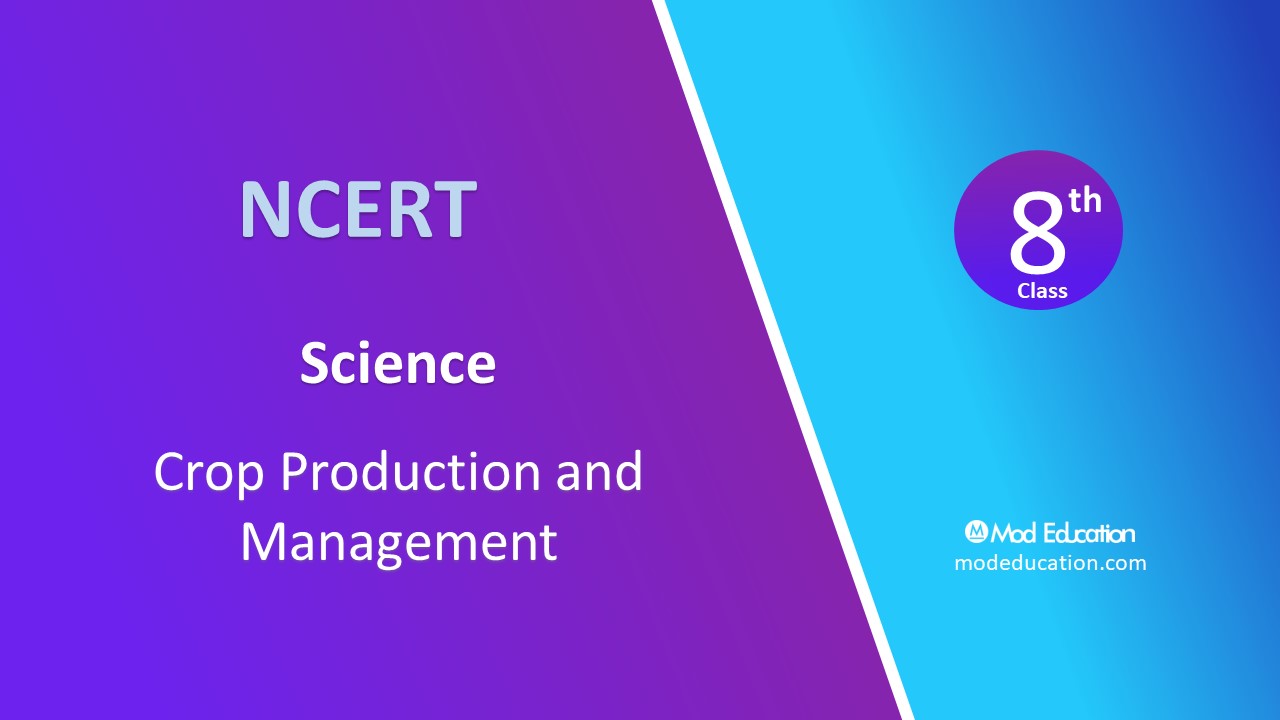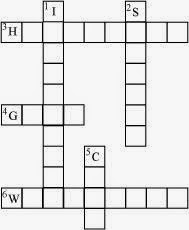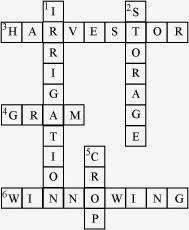CBSE NCERT Class 8 Science Chapter 1 Notes Crop Production and Management Chapter Solutions Question answer and important question and worksheet for chapter 1 class 8 Science
Class 8 Science Chapter 1 in Hindi फसल उत्पादन एवं प्रबंध Click Here
| Section Name | Topic Name |
| 1 | Crop Production and Management |
| 1.1 | Agricultural Practices |
| 1.2 | Basic Practices of Crop Production |
| 1.3 | Preparation of Soil |
| 1.4 | Sowing |
| 1.5 | Adding Manure and Fertilisers |
| 1.6 | Irrigation |
| 1.7 | Protection from Weeds |
| 1.8 | Harvesting |
| 1.9 | Storage |
| 1.10 | Food from Animals |
NCERT SCIENCE Books PDF Download
NCERT Solutions for Class 8 Science Chapter 1 Crop Production and Management

Crop Production and Management class 8 notes NCERT Q&A
Question 1. Select the correct word from the following list and fill in the blanks. (float, water, crop, nutrients, preparation)
(a) The same kind of plants grown and cultivated on a large scale at a place is called ________
(b) The first step before growing crops is _________ of the soil.
(c) Damaged seeds would _________ on top of the water.
(d) For growing a crop, sufficient sunlight and _________and__________ from the soil are essential.
Answer:
(a) crop
(b) preparation
(c) float
(d) water, nutrients
Question 2. Match items in column A with those in column B.
| A | B |
| (i) Kharif crops | (a) Food for cattle |
| (ii) Rabi crops | (b) Urea and superphosphate |
| (iii) Chemical fertilisers | (c) Animal excreta, cow dung, urine and plant waste |
| (iv) Organic manure | (d) Wheat, gram, pea |
| (e) Paddy and maize |
Answer:
(i) (e)
(ii) (d)
(iii) (b)
(iv) (c)
Question 3. Give two examples of each.
(a) Kharif crop
(b) Rabi crop
Answer:
(a) Kharif crop: Paddy and maize
(b) Rabi crop: Wheat and gram
Question 4. Write a paragraph in your own words on each of the following.
(a) Preparation of soil
(b) Sowing
(c) Weeding
(d) Threshing
Answer:
(a) Preparation of soil: Soil preparation is necessary before growing a crop. It involves tilling and loosening the soil. This allows the roots to penetrate deep in the soil and to breath easily even when they are deep.
(b) Sowing: The process of putting seeds into the soil is called sowing. The tool used traditionally for sowing seeds is funnel-shaped. Nowadays a seed drill is used for sowing with the help of tractors. This tool sows the seed uniformly at a proper distance and depth.
(c) Weeding: Some undesirable plants grow along with crop and these unwanted plants are called weeds. The process of removing these unwanted plants is called weeding.
(d) Threshing: The process of separating the grain seeds from the chaff is called threshing.
Question 5. Explain how fertilisers are different from manure.
Answer:
| Fertilisers | Manures |
|---|---|
| (i) A fertiliser is an inorganic salt. | (i) Manure is a natural substance obtained by the decomposition of cattle dung, human waste and plant residues. |
| (ii) A fertiliser is prepared in factories. | (ii) Manure can be prepared in the fields. |
| (iii) A fertiliser does not provide any humus to the soil. | (iii) Manure provides a lot of humus to the soil. |
| (iv) Fertilisers are very rich in plant nutrients like nitrogen, phosphorus and potassium. | (iv) Manure is relatively less rich in plant nutrients. |
Question 6. What is irrigation? Describe two methods of irrigation which conserve water.
Answer:
The artificial method of watering the plants for assisting in their growth is called irrigation. Main sources of irrigation are wells, tube-wells, ponds, lakes, rivers.
Two methods which help us to conserve water are:
(i) Sprinkler irrigation system: This irrigation system has an arrangement of vertical pipes with rotating nozzles on the top. It is more useful in the uneven and sandy land where sufficient water is not available.
(ii) Drip irrigation system: This irrigation system has an arrangement of pipes or tubes with very small holes in them to water plants drop by drop just at the base of the root. It is very efficient as water is not wasted at all.
Question 7. If wheat is sown in the kharif season, what would happen? Discuss.
Answer:
Wheat crop is sown from December/December to March/April. It is grown in winter and requires less water. If wheat is sown in Kharif season, its production will be decreased considerably.
Question 8. Explain how soil gets affected by the continuous plantation of crops in a field.
Answer:
Continuous plantation of crops makes the soil poorer in certain nutrients as the crops take up nutrients from the soil. The soil becomes infertile. It does not get enough time to replenish the nutrients.
Question 9. What are the weeds? How can we control them?
Answer:
The undesirable and unwanted plants which grow naturally along with the crop are called weeds. The growth of weeds can be controlled by adopting many ways. Tilling before sowing of crops helps in the uprooting and killing of weeds, which may then dry up and get mixed with the soil. Weeds are also controlled by using certain chemicals, called weedicides. Weedicides are sprayed in the fields to kill the weeds.
Question 10. Arrange the following boxes in proper order to make a flow chart of sugarcane crop production.

Answer

Complete the following word puzzle with the help of clues given below.
Down
1. Providing water to the crops.
2. Keeping crop grains for a long time under proper conditions.
5. Certain plants of the same kind grown on a large scale.
Across
3. A machine used for cutting the matured crop.
4. A rabi crop that is also one of the pulses.
6. A process of separating the grain from chaff.

Answer
Down
1. IRRIGATION
2. STORAGE
5. CROP
Across
3. HARVESTOR
4. GRAM
6. WINNOWING

8 Science Chapter 1 Crop Production and Management – Notes
- When plants of the same kind are cultivated at one place on a large scale, it is called a crop.
- The crops which are sown in the rainy season (June to September) are called kharif crops.
- The crops grown in the winter season (December to March) are called rabi crops.
- Various tasks performed by a farmer to produce a good crop are called agricultural practices. These are:
- Preparation of soil
- Sowing
- Use of manure and fertiliser
- Irrigation of crops
- Protection from weeds
- Harvesting
- Storage of food grain.
- Preparation of Soil : It is the first step before growing a crop. The loosened soil helps in the growth of earthworms and microbes present in the soil. The process of loosening and turning of the soil is called tilling or ploughing. The main tools used for this purpose are the plough, hoe and cultivator.
- Sowing : The process of placing seeds in the soil is known as Sowing. Before sowing, good quality, clean and healthy seeds of a good variety are selected.
- Use of manure and fertiliser: Continuous growing of crop in the field causes deficiency of mineral nutrients in the soil. So, the manure is added to the soil to make up the deficiency of mineral nutrients. Manure is prepared from cow dung, urine and other wastes.
- Irrigation of crops: The supply of water to crops at regular intervals is called irrigation. The time and frequency of irrigation varies from crop to crop, soil to soil and season to season. Traditional methods include Moat (pulley-system), Chain pump, Dhekli, Rahat and Modern methods include Sprinkler system and Drip system.
- Protection from weeds: The unwanted plants in the fields are called weeds. The removal of weeds is called weeding. Weeding is necessary since weeds compete with the crop plants for water, nutrients, space and light.
- Harvesting: The cutting of crop after it is mature is called harvesting. In harvesting, crops are pulled out or cut close to the ground. Harvesting is either done manually by a sickle or by a machine called harvester. The whole process of separation of the grains from the harvested crop is known as threshing.
- Storage of food grain: Farmers store grains in jute bags or metallic bins. However, large scale storage of grains is done in silos and granaries to protect them from pests like rats and insects.
- Food from Animals: Food is also obtained from animals for which animals are reared and provided with proper food, shelter and care. When done on a large scale, it is called animal husbandry.
NCERT Solutions for Class 8 Science Chapter 1 Crop Production and Management – MCQ Questions with Answers
- Which irrigation system consists of pulleys
a) Sprinkler.
b) Moat.
c) Dhekli.
d) Rahat.
b) Moat.
- Harvesting is the method of
a) Uproot weeds.
b) Cutting crops.
c) Cutting matured crops.
d) Uniform placing of crops.
c) Cutting matured crops.
- Khurpi is basically used
a) To uproot weeds.
b) To spread seeds.
c) To irrigate crops.
d) As weedicides.
a) To uproot weeds.
- For plants NPK is
a) Micro nutrients.
b) Supplementary nutrients.
c) Macro nutrients.
d) None of the above.
c) Macro nutrients.
- Which one provides a lot of humus to the soil?
a) Manure.
b) Fertilizers.
c) Rhizobium bacteria.
d) All of the above.
a) Manure.
- The management of rearing animals for food and their products is known as
a) Poultry.
b) Agriculture.
c) Animal husbandry.
d) Warehouse.
c) Animal husbandry.
- Nabanya is harvesting festival of
a) Andhra Pradesh.
b) Assam.
c) Arunachal Pradesh.
d) West Bengal.
d) West Bengal.
- Mustard is an example of
a) Kharif crops.
b) Rabi crops.
c) Fodders.
d) None of the above.
b) Rabi crops.
- Manuring of soil is carried out to
a) Replenish the soil with nutrients.
b) Uniformly distribute the soil nutrients.
c) Help soil to pass air through its gap.
d) Rearing farmers friends.
a) Replenish the soil with nutrients.
- The bulk amount of seeds are stored in
a) Granaries.
b) Silos.
c) Cotton bag.
d) All of the above.
b) Silos.
NCERT Solutions for Class 8 Science Chapter 1 Crop Production and Management Video
8 science chapter 1 Crop Production and Management Video Part 1
8 Science Chapter 1 Crop Production and Management Video Part 2
8 Science Chapter 1 Crop Production and Management Video Part 3
8 Science Chapter 1 Crop Production and Management Video Part 4
Best NCERT Solutions for Class 8 Science all Chapters
Youtube
what are Weeds?
In the simplest terms, weeds can be defined as undesirable plants that grow in a field naturally along with the desirable crop. Most farmers remove these weeds at an early stage of growth so that these plants don’t interfere with the proper growth of the main crop.
What do You Understand by Irrigation?
Irrigation can be defined as the process of supplying water to crops at regular intervals of time.
NCERT Class 8 Science All Chapter
- Chapter 1: Crop Production and Management
- Chapter 1 : फसल उत्पादन एवं प्रबंध
- Chapter 2: Microorganisms: Friend and Foe
- Chapter 2 : सूक्ष्मजीव: मित्र एवं शत्रु
- Chapter 3: Synthetic Fibres and Plastics
- Chapter 3 : संश्लेषित तन्तु एवं प्लास्टिक
- Chapter 4: Materials: Metals and Non-Metals
- Chapter 4 : पदार्थ: धातु और अधातु
- Chapter 5: Coal and Petroleum
- Chapter 5: कोयला और पेट्रोलियम
- Chapter 6: Combustion and Flame
- Chapter 6: दहन और ज्वाला
- Chapter 7: Conservation of Plants and Animals
- Chapter 8: Cell – Structure and Functions
- Chapter 9: Reproduction in Animals
- Chapter 10: Reaching the Age of Adolescence
- Chapter 11: Force and Pressure
- Chapter 12: Friction
- Chapter 13: Sound
- Chapter 14: Chemical Effects of Electric Current
- Chapter 15: Some Natural Phenomena
- Chapter 16: Light
- Chapter 17: Stars and The Solar System
- Chapter 18: Pollution of Air and Water
